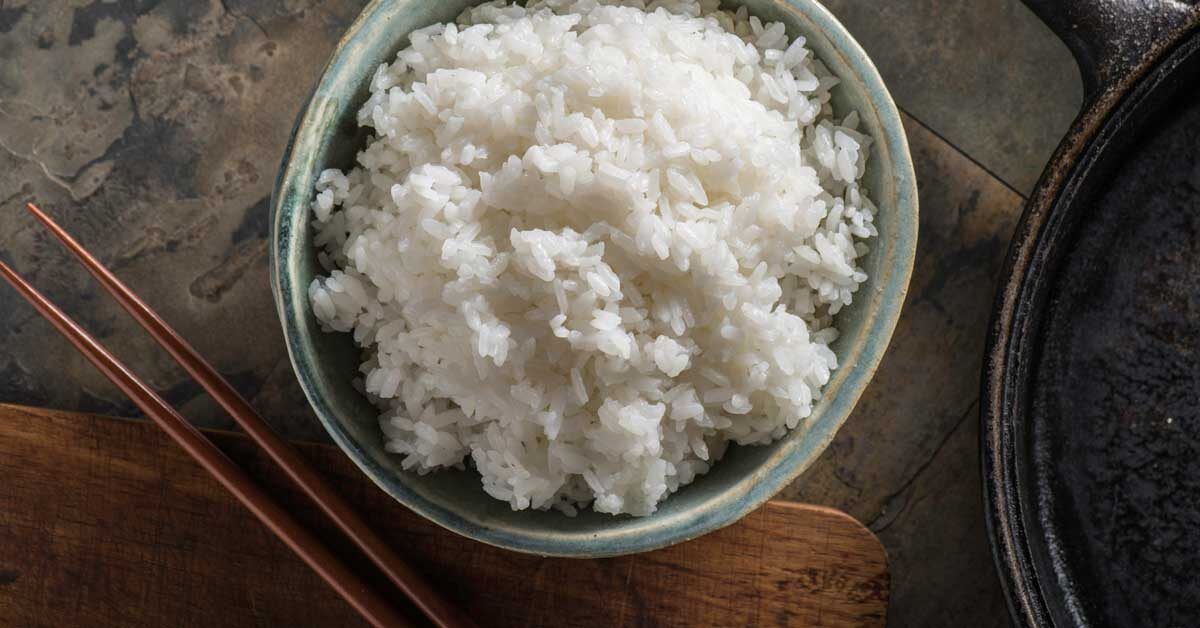White rice is not inherently inferior to brown rice and offers nutritional benefits, including minerals. It’s low in fiber, fat, and calories and can be paired with fiber-rich foods to boost a meal’s nutritional profile.
While white rice is processed, it’s usually enriched with added nutrients, and its low fiber content may help with digestive issues. White rice does contain nutrients such as magnesium, phosphorous, manganese, selenium, iron, folic acid, thiamin, and niacin, according to research.
However, brown rice has the germ and bran intact, which contribute additional nutrients like fiber, fat, protein, B-vitamins, iron, phosphorus, potassium, and zinc that white rice lacks. Ultimately, both white and brown rice can be part of a healthy diet when consumed in moderation and paired with a variety of nutrient-dense foods.

Is White Rice Healthy?
Research suggests that white rice is not inherently inferior to brown rice and can offer nutritional benefits, such as minerals. While it may be low in fiber, fat, and calories, pairing it with fiber-rich foods can enhance its nutritional profile.
White rice may have a bad reputation, but it actually offers some nutritional benefits. While it lacks the fiber and certain nutrients found in brown rice, it still contains essential minerals like manganese, selenium, and magnesium. These minerals play a key role in maintaining healthy bodily functions. White rice is also low in fat and calories, making it a suitable option for individuals watching their weight or on a calorie-restricted diet. Additionally, it can be paired with fiber-rich foods to create a balanced meal that provides a combination of nutrients. Overall, white rice can be a part of a healthy diet when consumed in moderation and combined with other nutritious components.
The debate between white rice and brown rice often revolves around their nutritional value. Brown rice is considered healthier because it retains the bran and germ, which contain fiber, protein, and several essential nutrients. The fiber in brown rice can aid in digestion, promote satiety, and help regulate blood sugar levels. However, white rice has its own advantages. It has a longer shelf life and a milder taste, making it more versatile in cooking. Additionally, white rice is easier to digest for some individuals, especially those with digestive issues or sensitive stomachs. Ultimately, the choice between white and brown rice depends on personal preference, dietary needs, and health goals.
While white rice does offer nutritional benefits, there are potential risks associated with its consumption. One of the main concerns is its high glycemic index, which means it can cause a rapid rise in blood sugar levels. This can be detrimental for individuals with diabetes or those at risk of developing it. However, pairing white rice with foods that have a lower glycemic index, such as vegetables or protein sources, can help mitigate this effect. Another concern is the potential presence of arsenic in rice, which can be higher in white rice compared to other types. Arsenic is a toxic substance that can accumulate in the body over time and have adverse health effects. To reduce the risk, it is recommended to rinse rice thoroughly before cooking and consume a varied diet that includes other grains. As with any food, moderation is key when it comes to white rice consumption.
In conclusion, white rice offers some nutritional benefits and can be included in a balanced diet. However, it’s important to consider individual health needs, preferences, and potential risks associated with its consumption. Incorporating other whole grains and fiber-rich foods into the diet can help ensure a diverse and nutritious eating plan.
:max_bytes(150000):strip_icc()/rice_annotated-b0a0aa51dc264e05b1d50b98c928147e.jpg)
Nutritional Benefits Of White Rice
White rice offers nutritional benefits, including minerals, despite myths that suggest otherwise. With low fiber, fat, and calorie content, it can be paired with fiber-rich foods to enhance a meal’s nutritional profile.
Mineral Content Of White Rice
White rice may be lacking in certain nutrients compared to other varieties, like brown rice, but it still provides some essential minerals. These minerals include:
- Manganese: White rice contains a significant amount of manganese, a mineral important for brain function and metabolism.
- Selenium: Selenium is an antioxidant that plays a role in thyroid function and immune health.
- Phosphorus: White rice is a decent source of phosphorus, which is essential for bone health and energy production.
- Magnesium: Though in smaller amounts than in other grains, white rice still contributes to your daily magnesium intake, which is necessary for muscle and nerve function.
While white rice may not be as nutrient-dense as other varieties, these minerals are still essential for overall health.
Low Fiber And Fat Content
One characteristic of white rice is its low fiber and fat content. While fiber is a crucial component of a healthy diet, some people with specific health conditions may benefit from low-fiber foods like white rice.
Additionally, the low-fat content of white rice can be advantageous for those watching their fat intake or following a low-fat diet.
Caloric Value Of White Rice
White rice has a relatively high caloric value compared to other grains. A 1-cup serving of cooked white rice typically contains around 200 calories. However, it’s important to note that the caloric value of rice can vary depending on factors such as cooking method and rice variety.
While white rice may be higher in calories compared to some alternatives, it can still be part of a balanced diet when consumed in moderation and paired with other nutrient-rich foods.
| Nutrient | White Rice | Brown Rice |
|---|---|---|
| Calories | 130 | 111 |
| Protein | 2.7g | 2.6g |
| Fat | 0.3g | 0.9g |
| Carbohydrates | 28.7g | 23.6g |
| Fiber | 0.4g | 1.8g |
| Magnesium | 13mg | 43mg |
| Iron | 0.4mg | 0.8mg |
| Potassium | 35mg | 43mg |
This table provides a comparison of the nutritional content per 100g between white rice and brown rice, highlighting some of the key differences. While brown rice generally has a higher nutritional value, white rice can still be a part of a balanced diet when consumed in moderation.
White Rice Vs. Brown Rice: Which Is Healthier?
When it comes to the debate between white rice and brown rice, many people wonder which one is healthier. Both varieties have different nutritional compositions and offer various health benefits. Let’s take a closer look at the differences and factors to consider when choosing between white and brown rice.
Differences In Nutritional Composition
White rice and brown rice differ significantly in their nutritional composition. White rice is processed and has the bran and germ removed, which removes essential nutrients and fiber. On the other hand, brown rice retains the bran and germ, making it a whole grain packed with fiber, vitamins, and minerals.
Here’s a comparison table that highlights the nutritional differences between white and brown rice:
| White Rice | Brown Rice | |
|---|---|---|
| Fiber | Low | High |
| Vitamins | Minimal | Abundant |
| Minerals | Minimal | Abundant |
Health Benefits Of Brown Rice
Brown rice, being a whole grain, offers numerous health benefits compared to white rice. It is rich in fiber, which promotes healthy digestion and regular bowel movements. The higher fiber content also aids in weight management and reduces the risk of developing chronic diseases like diabetes and heart disease.
Brown rice is also a good source of vitamins, such as vitamin B complex and vitamin E, which play a crucial role in maintaining overall health. Additionally, it contains minerals like magnesium, phosphorus, and selenium, which contribute to strong bones, a healthy immune system, and proper cellular function.
Considerations For Choosing Between White And Brown Rice
When deciding between white and brown rice, several factors should be taken into consideration. If you need to manage your blood sugar levels or are looking to lose weight, brown rice is the better option due to its lower glycemic index and higher fiber content.
However, it’s essential to note that white rice can still be a part of a healthy diet, especially if it is enriched with essential nutrients like iron and B vitamins. Moreover, white rice is more easily digested and may be preferred for individuals with digestive issues.
In conclusion, while brown rice takes the lead in terms of nutritional value, both white and brown rice can be part of a balanced diet. The key is to consider your dietary goals, preferences, and overall nutritional needs when making a choice.
Potential Risks Of White Rice Consumption
White rice consumption may pose potential risks due to its low fiber content, which may contribute to digestive issues. While white rice is enriched with added nutrients, research suggests that brown rice, with its intact bran and germ, may be a healthier option due to its higher fiber, fat, and protein content.
Impact On Blood Sugar And Metabolic Syndrome
Consuming white rice can have an impact on blood sugar levels and pose risks for individuals with metabolic syndrome. White rice has a high glycemic index, meaning it can cause a rapid increase in blood sugar levels after consumption. This can lead to spikes in insulin levels, potentially contributing to the development of metabolic syndrome.
Metabolic syndrome is a cluster of conditions, including high blood pressure, high blood sugar, excess abdominal fat, and abnormal cholesterol levels. Research suggests that regularly consuming white rice may increase the risk of developing metabolic syndrome. It is important to note that this association is more relevant for individuals who eat large quantities of white rice and have sedentary lifestyles.
Associations With Weight Gain And Obesity
White rice consumption has also been linked to weight gain and obesity. This is primarily attributed to its high carbohydrate content and low fiber content. White rice is digested quickly, leading to a rapid increase in blood sugar levels and subsequent insulin release. This can promote fat storage and contribute to weight gain over time.
Studies have shown that individuals who consume more white rice tend to have higher body mass indexes (BMIs) and higher rates of obesity compared to those who consume less white rice or opt for whole grain alternatives. Additionally, the lack of fiber in white rice can result in less satiety, leading to overeating and further contributing to weight gain.
Moderation And Pairing With Other Foods
While there are potential risks associated with white rice consumption, it is important to note that moderation and pairing with other foods can help mitigate these risks. Rather than completely eliminating white rice from your diet, it can be incorporated in moderate portions along with other nutrient-dense foods.
For individuals concerned about the impact on blood sugar levels, pairing white rice with protein, healthy fats, and fiber-rich foods can help slow down digestion and minimize blood sugar spikes. For example, enjoying white rice with grilled chicken and steamed vegetables can create a balanced meal that provides sustained energy and keeps blood sugar levels stable.
In conclusion, white rice consumption may have potential risks related to blood sugar levels, metabolic syndrome, weight gain, and obesity. However, with moderation and strategic pairing with other foods, it can still be enjoyed as part of a balanced diet. It is always important to consider individual health goals and consult with a healthcare professional or registered dietitian for personalized advice.

Frequently Asked Questions Of Is White Rice Healthy? What Does Research Say About It?
Is There Anything Healthy About White Rice?
White rice offers some nutritional benefits, including minerals, and is low in fiber, fat, and calories. It can be paired with fiber-rich foods to enhance its nutritional profile. Though brown rice is generally considered healthier due to its higher fiber content, white rice is still nutritious and may help with digestive issues.
Is Rice An Inflammatory Food?
No, rice is not an inflammatory food. White rice offers nutritional benefits, including minerals. It is low in fiber, fat, and calories. Pairing it with fiber-rich foods boosts its nutritional profile.
Which Type Of Rice Is The Healthiest?
Brown rice is considered the healthiest type of rice due to its higher fiber, fat, and protein content compared to white rice. Whole grain rice, such as brown or black rice, provides more nutritional benefits and is recommended for a healthier diet.
Why Is Brown Rice Healthier Than White Rice?
Brown rice is healthier than white rice because it retains the nutrient-rich bran and germ. These parts provide fiber, fat, protein, and essential vitamins and minerals. White rice, on the other hand, lacks these nutrients. Switching to brown rice can improve your overall nutritional intake.
Conclusion
Overall, while white rice may not be as nutrient-rich as brown rice, it still offers some nutritional benefits. Its low fiber content makes it easier to digest and it can be paired with fiber-rich foods to enhance its nutritional profile.
Additionally, white rice is often enriched with added nutrients, making it a viable option for those looking to incorporate it into their diets. Ultimately, whether white rice is healthy or not depends on individual dietary needs and preferences.


